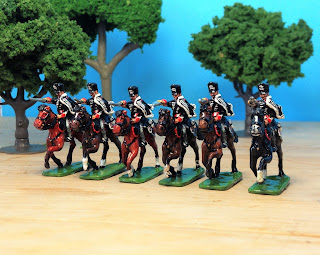 |
| PN 85: Prussian Hussars, One Piece Casting |
The question of squadron size has been pre-occupying me a lot lately. Although six-figure squadrons really look the part, in terms of figure ratios they may be a little excessive. Given that the infantry battalions have a ratio in the region of 1:33, six-figure squadrons represent almost 200 men,
 Another reason for adopting a four-figure squadron standard is that most of my cavalry are Der Kriegspielers, which tend to come in groups of eight as it was in packets of eight that they were originally marketed.
Another reason for adopting a four-figure squadron standard is that most of my cavalry are Der Kriegspielers, which tend to come in groups of eight as it was in packets of eight that they were originally marketed.The problem with four-figure squadrons, on the other hand, is that they look a little too weedy!
The solution, perhaps, would be to adopt a variable squadron size depending on how many figures are available. It would certainly be the most economical way of using of the figures.
WM
Nicely done, love the poses!
ReplyDeleteCheers Phil. The pose variation is more to do with my wobbly painting than it is with the castings, although now I come to look at them again I can see that the third from the left is actually a DK, Doh!
DeleteI do like one piece castings ! , Tony
ReplyDeleteCertainly little chance of losing either the horse or rider!
DeleteYou can vary arm psitions, head direction and the horses head if you want to go for variety! I'd go for six figyre squadrons where you can. When its a matter of castings from John that are available in numbers and four where you cannit get more figures, but based in such a way that you can always add two more if they turn up!
ReplyDeleteMmmmm....have cake AND eat it....I like the sound of that!
DeleteThey look smashing - really good - I like the OPC figures too - you don't get the chimpy legs which the dismountable boys are noted for. I have 10-man cavalry units as standard, simply because at 33:1 that's a decent 2-squadron strength (and also, of course, because one of the early Featherstone books recommended 10), but I frequently wish I'd gone for 12, because 10 is a rubbish number for making neat formations - you can have column of march (in 2s, for me), 2 rows of 5, or one of 10, and that's it.
ReplyDeleteI think that 4 and 6-figure squadrons could be made to work provided that the smaller units field a minimum of 2 squadrons, and there will always be the option of expanding them if more figures turn up, of course.
DeleteVery nicely done, will look forward to seeing the completed unit.
ReplyDeletePaul
Cheers Paul
DeleteNicely done Matt. I agree with Tony that 6 figures are more versatile for formations and I think Roy has a good idea as well about going with the 4's where you have them hoping the extra figures will turn up eventually - in my experience they will!
ReplyDeleteWorth a try, I'd say. The worst that could happen is that I will end up with too many painted figures!
DeleteLike the figures a lot.
ReplyDeleteYou seem to be following Bruce Quarrie's scaling. British regiments typically had 3 squadrons in the field each of about 125-150 men so 4 men to a squadron and 3 squadrons to a regiment. The Life Guards and RHG had 2 squadrons.
For Prussians, he states that squadrons were 120 men strong so three to four figures- he thinks four is best. With 4 squadrons to a regiment, you could have 12 or 16 figures. Why don't you go for 3 figure squadrons (12 figure regiments) then build up to 16 when you get the figures?
By the way, he thinks French regiments should have 5 figures per squadron and 4 squadrons per regiment.
Thanks Man. Yes, I thought of Bruce while I was pondering this problem, but suspect in that direction madness lies! Sticking to a standard, stylised unit organisation has too many advantages, I feel (including not having to think too hard about it). However, as most of my cavalry are in odd mutliples I'm prepared to make a few exceptions!
Delete